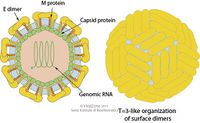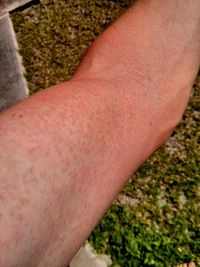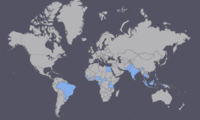Zika virus: Difference between revisions
| Line 37: | Line 37: | ||
In addition to sexual contact, studies have shown that ZIKV can reside in blood transfusions and they can be a possible vector for human-to-human transmission. [[#Reference|[5]]] | In addition to sexual contact, studies have shown that ZIKV can reside in blood transfusions and they can be a possible vector for human-to-human transmission. [[#Reference|[5]]] | ||
===Zika Fever=== | ===Zika Fever and ZIKV Pathogenesis=== | ||
Zika fever is the disease associated with ZIKV infection. | Zika fever is the disease associated with ZIKV infection. While there are scarce resources describing ZIKV pathogenesis exclusively, the general consensus is that mosquito-borne flaviviruses replicate initially in the dendritic cells at the site of infection where it then spreads to other areas of the body via the bloodstream and lymphatic system. Viral replication typically occurs in the cytoplasm of infected cells, but there is a study that shows ZIKV antigens can also be found in the nuclei of infected host cells. [[#Reference|[2]]] | ||
====Symptoms==== | ====Symptoms==== | ||
[[Image:Zikarash.jpeg|thumb|200px|right| Characteristic rash caused by Zika fever. [https://en.wikipedia.org/wiki/Zika_virus].]] | [[Image:Zikarash.jpeg|thumb|200px|right| Characteristic rash caused by Zika fever. [https://en.wikipedia.org/wiki/Zika_virus].]] | ||
Revision as of 08:59, 25 July 2015
Baltimore Classification and Taxonomy
Group IV: (+) sense single-stranded RNA virus
| Order = Unassigned
| Family = Flaviviridae
| Genus = Flavivirus
| species = Zika virus
{|NCBI: Taxonomy Genome: Genome|}
Description and Significance
Zika virus (ZIKV) is a mosquito-borne flavivirus that was first isolated from a rhesus monkey in the Zika forest of Uganda in 1947. [3] In 1968, isolation from human hosts occurred in residents of Nigeria. [2] Since then, multiple studies have confirmed ZIKV antibody in humans from a multitude of countries in Africa and parts of Asia. [2] In 2015, ZIKV first appeared outside of Africa and Asia when it was isolated in Brazil where is has caused a minor outbreak following the 2014 FIFA World Cup. [4] ZIKV is closely related to other mosquito-borne flaviviruses such as the dengue, yellow fever, West Nile, and Japanese encephalitis viruses. [2] ZIKV causes a disease known as Zika fever, which is characterized by a macropapular rash covering the body, fever, joint pain, and malaise. [2] Although there have yet to be serious complications arising from ZIKV, it's appearance across the globe, mosquito-driven transmission cycle, and possible spread via sexual contact make ZIKV an important emerging pathogen whose global impact is yet to be discovered.
Genome Structure
The Zika virus is a positive sense single-stranded RNA molecule that is 10794 kb long with two non-coding flanking regions. It encodes for a polyprotein that is cleaved to form segments for capsid, membrane, envelope, seven other non-structural proteins. The envelope protein makes up a majority of the virion surface and is involved with aspects of replication such as host cell binding and membrane fusion. [3]
Virion Structure of a Zika virus

The structure of ZIKV follows that of other flaviviruses. It contains a nucleocapsid approximately 25-30 nm in diameter surrounded by a host-membrane derived lipid bilayer that contains envelope proteins E and M. The virion is approximately 40 nm in diameter with surface projections that measure roughly 5-10 nm. [8] The surface proteins are arranged in an icosohedral-like symmetry. [7]
Reproductive Cycle of a Zika virus in a Host Cell
The reproductive cycle of ZIKV follows that of other known flaviviruses. First, the virion attaches to the host cell membrane receptors via the envelope protein which induces virion endocytosis. Next, the virus membrane fuses with the endosomal membrane and the ssRNA genome of the virus is released into the cytoplasm of the host cell. It is then translated into a polyprotein that is subsequently cleaved to form all structural and non-structural proteins. Replication then takes place at intracellular compartments known as cytoplasmic viral factories in the endoplasmic reticulum resulting in a dsRNA genome. The dsRNA genome is then transcribed resulting in additional ssRNA genomes. Assembly then occurs within the endoplasmic reiticulum and the new virions are transported to the Golgi apparatus and then excreted into the intracellular space where the new virions can infect new host cells. [7]
Viral Ecology & Pathology
Epidemiology
Since it's first detection in Uganda, ZIKV has appeared in the following countries of Africa and Asia: Gabon, Egypt, Nigeria, Senegal, Sierra Leone, Côte d'Ivoire, Central African Republic, Cambodia, Micronesia, Malaysia, Pakistan, India, Thailand, Philippines, and Indonesia. [3] ZIKV has also presented itself in the Western world in 2015 when it was isolated in Brazil, likely a result of the 2014 World Cup. [4]
Transmission
Mosquito-borne
ZIKV has been isolated from a variety of of mosquitoes of the genus Aedes . These include A. africanus, A. aegypti, A. vitattus, A. furcifer, A. apicoargenteus, and A. luteocephalus. (ref)
Human to Human
After returning from a research mission to Senegal, Dr. Brian Foy of the University of Colorado appeared to have passed ZIKV to his wife after sexual intercourse in 2008. Both Dr. Foy and his Ph.D. student Kevin Kobylinski were bitten by numerous mosquitoes while abroad and became ill about 5 days after returning to the U.S. Both showed signs of Zika fever and Dr. Foy's wife saw what she believed to be blood in his semen. Approximately 10 days later, Foy's wife showed signs of Zika fever while their four children remained healthy. At first it was believed that Foy had contracted dengue fever, but after Kobylinski had an encounter with medical entomologist Andrew Haddow who had experience with ZIKV, tests were run that confirmed all three patients possessed antibody for ZIKV. Circumstantial evidence suggests that sexual contact was the mode of transmission due to the high unlikeliness that Foy's wife was bitten by the tropical Aedes mosquito in Colorado. Additionally, the virus requires a 2-week life cycle in mosquito hosts before infecting humans and Foy's wife showed symptoms merely 10 days upon his return. [1]
In addition to sexual contact, studies have shown that ZIKV can reside in blood transfusions and they can be a possible vector for human-to-human transmission. [5]
Zika Fever and ZIKV Pathogenesis
Zika fever is the disease associated with ZIKV infection. While there are scarce resources describing ZIKV pathogenesis exclusively, the general consensus is that mosquito-borne flaviviruses replicate initially in the dendritic cells at the site of infection where it then spreads to other areas of the body via the bloodstream and lymphatic system. Viral replication typically occurs in the cytoplasm of infected cells, but there is a study that shows ZIKV antigens can also be found in the nuclei of infected host cells. [2]
Symptoms

The first well-documented case of Zika fever in 1964 describes symptoms as beginning with a headache and then continuing to include a maculopapular rash covering a significant portion of the body the following day. In addition, a fever was present as well as back pain and a general feeling of malaise. In 1973, a patient with Zika fever presented with fever, joint pain, and headache but the rash was absent. Another outbreak in Indonesia resulted in all 7 victims showing fever, but varying additional symptoms ranging from abdominal pain and dizziness to diarrhea and anorexia but no signs of rash. The outbreak on Yap Island showed the maculopapular rash, joint pain, and conjunctivitis. [2]
Diagnosis
Diagnosis for ZIKV infection include PCR tests to detect viral DNA as well as additional tests to detect ZIKV antibody (IgM) in serum. IgM for ZIKV is typically detectable around 3-5 days after infection, but cross-reactivity with closely related dengue, yellow fever, Japanese encephalitis, and West Nile viruses are possible. These cross-reactive results were more common in patients that denoted signs of previous flavivirus infection than patients with primary ZIKV infection. PCR tests should be conducted within 10 days of onset of illness. For best diagnosis practices, serum samples should be analyzed as early as possible with a second test 2 to 3 weeks after that. [2]
Treatment and Prevention
Presently, there is no vaccine for ZIKV or treatment for Zika fever. Because symptoms are relatively mild and the disease is self-limiting, only supportive therapy is employed. Patients with Zika fever should remain hydrated and rest. Acetaminophen can be prescribed to combat fever. [6]
Given that ZIKV is transmitted by mosquitoes, it is advocated by the CDC to use of insect repellent, long sleeved-clothing, and intervention in reducing the number of mosquito vectors. [2] Additionally, due to recent studies that show the possibility of sexual transmission, safe sex practices are also encouraged.
References
1 Enserink M. (2011) Sex After A Field Trip Yields Scientific First. Science Magazine
2 Hayes E. (2009) Zika Virus Outside Africa. CDC Emerging Infectious Diseases
6 Oakley A. (2014) Zika virus. DermNet NZ

